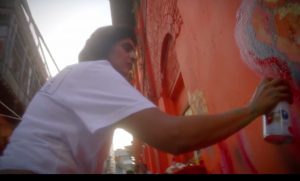The Indian government appears confused about the heritage protections given to architectural works of the Mughal period. Earlier this year the state of Uttar Pradesh, where the Taj Mahal is located, dropped India’s most famous building from its tourism brochure and its budget. The state had neglected the building for years partly because of its Muslim origin – its builder was the Mughal Emperor Shah Jahan.
Now India is outraged that sportswear company Puma spray painted graffiti on 17th century buildings (one also constructed by Shah Jahan) to make a gritty, hip-hop commercial for its “Suede Gully” shoe line.
Anti-Muslim Bias Expressed in Heritage Management

Dancers in Old Delhi in Suede-Gally video
The Taj Mahal, Shah Jahan’s mausoleum for his beloved wife Mumtaz Mahal, has been the subject of controversy in recent years. In 2015 the Times of India reported that tourism was declining and that the building was in poor repair. The recently elected Hindu Nationalist government in Uttar Pradesh, where the Taj Mahal is located, was accused of deliberately neglecting the historic site due to its Muslim history. The Taj Mahal was recently excluded from both the state cultural heritage budget and the state travel brochure.
Hindu nationalists say that the Taj Mahal was built on a Hindu temple (The BBC reports that there was actually a mansion at the site prior to the Taj Mahal) and is a monument to Muslim invaders of India. They feel that this part of their history is shameful and should be wiped from the historical record. For them, the Taj Mahal is a symbol of a legacy they’d rather forget. The argument of Hindu primacy has been used in the past to justify the destruction of ancient sites such as the Babri Mosque in India, along with other historical remains of Muslim culture.
The Puma Graffiti Episode
Puma arranged for graffiti enhancing its contemporary image to be sprayed onto several historic buildings and arches in order to “capture the grit of Indian streets” in its new ad for “Suede Gully” shoes.

Spray-painting on a monument
The name of the Puma shoe line, “Suede Gully”, is derived from the suede material the shoes are made of plus the Hindi word for street. The fast-moving, hip-hop music driven commercial depicts Puma-clothing-clad musicians and dancers performing at multiple sites throughout India. In addition to graffiti murals on architecture in Old Delhi, graffiti colors the inside of a train, and creates a ‘street’ mood in the financial district of Mumbai. Graffiti in bold, vibrant colors is everywhere in the ad. Perhaps intentionally, the commercial is reminiscent of the Indian festival of Diwali, in which paint and colored powder are tossed everywhere, at the same time that it advertises a new line of suede sports shoes.
Michael Safi, in an article in the Guardian, wrote, “a spokeswoman for Balancing Act, the creative agency employed by Puma for the campaign, said the company believed “all the required permissions [had] been obtained to carry out the video shoot and painting of the building”.
“Before carrying out the execution of art on the walls, we had taken permission from the owner of the property and as the property was a private one, we took his permission as that is all that is required,” she said.
“The owner wasn’t aware that his property is protected as a heritage property and hence we were not made aware.”’
Puma has apologized for the graffiti and has said it will restore the spray-painted buildings to their previous condition.
 Dancers in Old Delhi, India, in Suede-Gally video.
Dancers in Old Delhi, India, in Suede-Gally video. 

